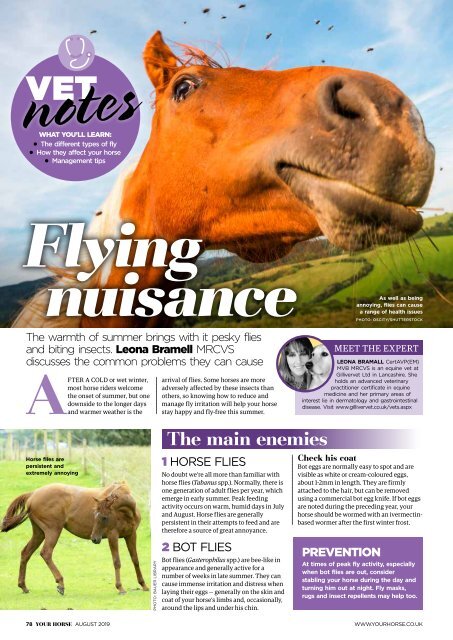Create successful ePaper yourself
Turn your PDF publications into a flip-book with our unique Google optimized e-Paper software.
vet notes l fighting flies<br />
notes<br />
vet<br />
What you’ll learn:<br />
l The different types of fly<br />
l How they affect your horse<br />
l Management tips<br />
Flying<br />
nuisance<br />
The warmth of summer brings with it pesky flies<br />
and biting insects. Leona Bramell MRCVS<br />
discusses the common problems they can cause<br />
After a cold or wet winter,<br />
most horse riders welcome<br />
the onset of summer, but one<br />
downside to the longer days<br />
and warmer weather is the<br />
arrival of flies. Some horses are more<br />
adversely affected by these insects than<br />
others, so knowing how to reduce and<br />
manage fly irritation will help your horse<br />
stay happy and fly-free this summer.<br />
As well as being<br />
annoying, flies can cause<br />
a range of health issues<br />
Photo: Oscity/Shutterstock<br />
meet the expert<br />
Leona Bramall CertAVP(EM)<br />
MVB MRCVS is an equine vet at<br />
Gillivervet Ltd in Lancashire. She<br />
holds an advanced veterinary<br />
practitioner certificate in equine<br />
medicine and her primary areas of<br />
interest lie in dermatology and gastrointestinal<br />
disease. Visit www.gillivervet.co.uk/vets.aspx<br />
Sweet itch<br />
Sweet itch is caused by an allergic<br />
reaction to the saliva of the Culicoides<br />
biting midge. Affected horses<br />
develop itching of the mane and tail<br />
and, in some cases, the face and poll.<br />
Itching begins in summer, but for<br />
some horses sweet itch can be a<br />
year-round problem. The level of<br />
severity varies; while some horses<br />
itch themselves bald, others may<br />
develop ulceration or secondary<br />
bacterial infections.<br />
Precautionary measures<br />
Prevention is based on reducing<br />
exposure to the offending midges.<br />
If at all possible, avoid fields with<br />
stagnant water or those adjacent to<br />
woodland areas that inherently have<br />
high midge populations. Horses<br />
affected with sweet itch should be<br />
stabled at dawn and dusk when the<br />
midges are most active. Fans may<br />
deter midges from entering stables.<br />
Sweet itch fly masks and rugs also<br />
play an integral role in prevention, as<br />
do fly and insect repellents, although<br />
the effectiveness of these varies.<br />
Veterinary intervention<br />
Contact your veterinary surgeon if<br />
itching continues despite using the<br />
above preventative measures, if skin<br />
is hot and inflamed, or if you’re<br />
concerned about possible infection.<br />
Your vet will examine your horse and<br />
may prescribe injectable, oral and/or<br />
topical (cream) medications.<br />
Insect hypersensitivity<br />
In addition to sweet itch, some horses can<br />
develop skin lumps (urticaria), with or<br />
without associated itching secondary to<br />
other flies and insects. Severity varies, from<br />
a small lump at the site of contact to an<br />
extensive hypersensitive response.<br />
Stick ‘em up<br />
If your horse is stabled during the day,<br />
ensure his stable is kept as clean as possible<br />
to reduce the number of flies in the stable<br />
environment. You can also spray the stable<br />
with fly repellents, but don’t spray directly<br />
near water or feed buckets.<br />
If the lumps are extensive, don’t appear<br />
to be resolving, or make your horse itch,<br />
seek advice from your veterinary surgeon.<br />
Contact your vet<br />
if lumps become<br />
itchy or don’t<br />
resolve on their own<br />
Sweet itch fly<br />
masks and rugs<br />
help reduce<br />
exposure to<br />
midges<br />
Lumps on your horse’s<br />
skin can indicate a<br />
hypersensitive response<br />
Photo: Bauer library<br />
Photos: Leona Bramall<br />
Horse flies are<br />
persistent and<br />
extremely annoying<br />
Photo: Bauer library<br />
The main enemies<br />
1 Horse flies<br />
No doubt we’re all more than familiar with<br />
horse flies (Tabanus spp.). Normally, there is<br />
one generation of adult flies per year, which<br />
emerge in early summer. Peak feeding<br />
activity occurs on warm, humid days in July<br />
and August. Horse flies are generally<br />
persistent in their attempts to feed and are<br />
therefore a source of great annoyance.<br />
2 Bot flies<br />
Bot flies (Gasterophilus spp.) are bee-like in<br />
appearance and generally active for a<br />
number of weeks in late summer. They can<br />
cause immense irritation and distress when<br />
laying their eggs — generally on the skin and<br />
coat of your horse’s limbs and, occasionally,<br />
around the lips and under his chin.<br />
Check his coat<br />
Bot eggs are normally easy to spot and are<br />
visible as white or cream-coloured eggs,<br />
about 1-2mm in length. They are firmly<br />
attached to the hair, but can be removed<br />
using a commercial bot egg knife. If bot eggs<br />
are noted during the preceding year, your<br />
horse should be wormed with an ivermectinbased<br />
wormer after the first winter frost.<br />
Prevention<br />
At times of peak fly activity, especially<br />
when bot flies are out, consider<br />
stabling your horse during the day and<br />
turning him out at night. Fly masks,<br />
rugs and insect repellents may help too.<br />
Sarcoids<br />
These are arguably the most prevalent form<br />
of skin tumour in non-grey horses. They are<br />
believed to be caused by a strain of bovine<br />
papilloma virus and transmitted by flies, so<br />
summer is a key time for spread. Fly control<br />
plays an integral role in preventing and<br />
reducing sarcoids.<br />
It is likely that individual horses have a<br />
genetic predisposition for the disease.<br />
Sarcoids can occur at any location on the<br />
skin, but the most commonly affected areas<br />
are those prone to sweating — which, in turn,<br />
attract flies — such as the armpits, inside of<br />
the hindlimbs and, in geldings, the sheath.<br />
Spotting the signs<br />
There are six different types of sarcoid, so if<br />
you notice any skin masses or lesions on<br />
your horse that you’re concerned about, seek<br />
advice from your veterinary surgeon.<br />
Sarcoids can occur<br />
anywhere on the<br />
horse’s body<br />
Sarcoids are skin tumours, so early<br />
detection and treatment as advised by your<br />
veterinary surgeon is very important. Early<br />
intervention enables the sarcoid to be<br />
treated before it increases further in size and<br />
reduces the chance of spread and further<br />
lesions developing. The treatment<br />
recommended by your vet will depend on<br />
the type of sarcoid and its location.<br />
Photo: Leona Bramall<br />
Fly strike<br />
Although not a pleasant thought,<br />
open wounds can sometimes be<br />
subject to fly strike, whereby green<br />
and bluebottle flies feed and lay their<br />
eggs, with the fly larvae/maggots<br />
hatching three or four days later.<br />
To prevent this, open wounds<br />
should be managed appropriately<br />
by keeping them clean and covered<br />
(see Managing wounds, p74) and fly<br />
control measures should be used.<br />
If you notice a larval-infested<br />
wound, contact your veterinary<br />
surgeon. They will likely advise<br />
hosing the wound and subsequently<br />
cleaning it with a disinfectant. The<br />
vet will generally visit and administer<br />
an injection against the larvae.<br />
78 your horse august 2019 www.yourhorse.co.uk www.yourhorse.co.uk<br />
august 2019 your horse 79

















